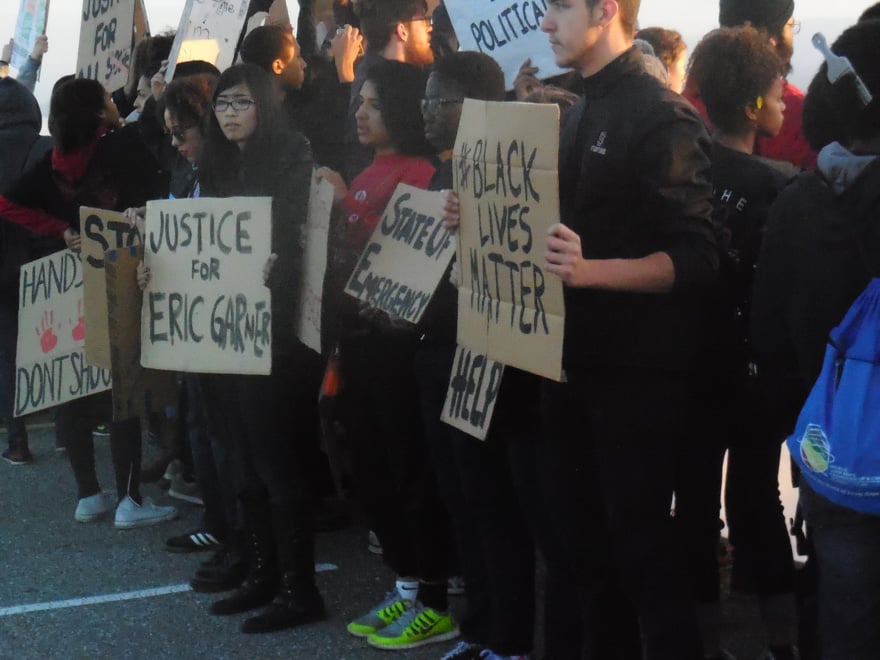Monday afternoon, Stanford students and community members shut down the San Mateo-Hayward Bridge in support of the Ferguson Action national demands, which include the demilitarization of local law enforcement and the repurposing of law enforcement funds to support community-based alternatives to incarceration.
According to Silicon Shut Down’s Twitter feed, 68 people were arrested in total. According to an email sent out to the Stanford community, 57 people were released and 11 have been sent to jail.
During the demonstration, participants engaged in nonviolent civil disobedience and attempted to block the westbound side of the bridge for 28 minutes to symbolize the fact that every 28 hours, a black person is killed by a police officer or vigilante, stated a press release from Silicon Shut Down, a collective of students that “organize in West Palo Alto, East Palo Alto and the Silicon Valley against state-sanctioned violence (police brutality) and other forms of systemic oppression,” according to their website.
Approximately 70 demonstrators initially assembled on Wilbur Field, where they conducted preparations for the bridge shutdown. After sorting out transportation arrangements, the demonstrators traveled in several cars to Southgate Park in Hayward, where final preparations were conducted.
While the demonstrators were at the park, a Hayward Police officer pulled up in a squad car and inquired about the intentions of the protesters. The police officer was looking into a concern that the large group of people was planning on committing a burglary. After the police officer was persuaded that this was not the case, the officer asked if a protest was going to happen in Hayward. Demonstrators told the police officer that this was not the case, which was a true statement because the protest occurred on the San Mateo County side of the San Mateo Bridge.
After the final staging for the protest was complete, the demonstrators drove to the San Mateo Bridge. The demonstrators stopped traffic close to the highest point in the span. When cars with more demonstrators got stuck in the suddenly building traffic, the demonstrators (except designated drivers) got out of the cars and ran up to the front of the traffic jam to join their fellow demonstrators. The demonstrators who were blocking traffic formed a line and held a number of signs as they chanted slogans.
A few yards behind the demonstrators was a line of heavily equipped California Highway Patrol (CHP) officers. Although a few officers were to the east of the demonstrators, the bulk of the officers were on the western side of the line. The CHP promptly charged the line of demonstrators and arrested them all.
The most obvious immediate reactions among the drivers who were stuck in traffic were puzzlement and anger. One man complained that the protest was lengthening a commute that was already an hour each way.
A few minutes after the CHP charged the demonstrators, they successfully cleared them off to the side of the road. The demonstrators continued to chant as they were sitting in CHP custody. The CHP initially opened up one lane to allow the pent-up traffic to clear. According to the San Francisco Chronicle, the San Mateo Bridge was at least briefly closed to traffic.
According to protest participant Kristian Davis Bailey ’14, 11 protesters, 10 of whom were female, were put in jail while the rest were offered the option of being cited and released.
According to Bailey, the citations some protesters were issued included obstruction of entry on a public land, obstructing people’s moment and creating a public nuisance. In an effort to help collect funds for bail, Silicon Shut Down organizers set up a Venmo account for those protesters still in jail.
When asked why he participated in the protest, Bailey said, “I realized that it was time to put my body on the line and use my privilege as a Stanford student to elevate the issues of Black Lives Matter.”
Protest participant Michaela Ben Izzy ’18 said, “I’m really proud of everyone who was out there today.”
Additionally, during the demonstration, students held banners calling attention to the violence committed against black communities as well as the Palestinian and Mexican flags as an act of public solidarity with victims of state-sponsored and U.S.-sponsored violence in Mexico and Palestine.
“Combating the triplets of racism, militarism and materialism was one of the biggest legacies King left us,” said Bailey in a public statement. “We proudly carry the Palestinian flag as we call on Stanford to divest from human rights violations in the occupation and related state violence in the U.S. The recent trip of Black Lives Matter and Ferguson representatives to Palestine signifies these movements are coming together on a global scale.”
Protesters chose to inconvenience the weekend commute in order to remind Silicon Valley that “it can’t ignore oppression in the midst of its own comfort.”
“We chose to inconvenience the weekend commute because the status quo is deadly to the black and brown peoples of this country and can no longer be tolerated,” said participant Maria Diaz ’17. “We are honoring MLK’s legacy by forcefully reminding Silicon Valley that, decades after Martin Luther King, black lives, and brown lives, and the lives of all oppressed people, still matter.”
In the past, Silicon Shut Down has formed demonstrations last Thanksgiving, reacting to the grand jury decision not to indict Ferguson police officer Darren Wilson in the fatal shooting of 18-year-old Michael Brown August last year, as well as in December, reacting to the decision not to prosecute a New York police officer in the death of unarmed black man Eric Garner.
In a statement to The Daily, University spokeswoman Lisa Lapin said, “We respect our students’ right to express themselves in peaceful protest. But we expect them to understand the consequences of protests that violate the law or the rights of others.”
Catherine Zaw contributed to this report.
Contact Caleb Smith at caleb17 ‘at’ stanford.edu.
This post has been updated.
